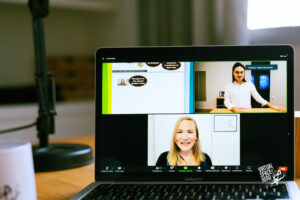Written by

Sina Brust
#virtualspacehero
Virtual communication skills can make or break our professional and personal interactions. Whether you’re leading a Zoom meeting, recording a webinar, or just catching up with friends and family, having effective virtual communication skills is essential. But let’s be honest, being engaging and charismatic on camera isn’t always easy. Inspired by Cat Mulvihill ‘s talk at the Remote Works event, we’ll share valuable tips on mastering effective virtual communication skills to elevate your online presence.
Why Effective Virtual Communication Skills Matter
First things first, why should we care about effective virtual communication skills? It’s simple: our world is more connected than ever before. We can talk to people across borders and time zones with the click of a button. But while technology makes it easy to connect, it also makes it easy to disconnect. Poor virtual communication can lead to misunderstandings, boredom, and a lack of engagement. And nobody wants that, right?
Let’s face it, virtual meetings and recordings can be draining. It’s easy to feel invisible on a crowded video call or distracted by notifications while watching a recording. The key to overcoming these challenges lies in developing effective virtual communication skills. When you master these skills, you can keep your audience engaged, make meaningful connections, and ensure your message is heard loud and clear.
The Three E’s of Effective Virtual Communication
To help you on your journey to mastering effective virtual communication skills, let’s introduce the Three E’s: Eye Contact, Emotionality, and Energy. These three elements will transform your virtual presence and make you a more engaging and effective communicator.
➡️ Eye Contact: Your Secret Weapon
Eye contact is crucial in any communication, but it’s even more important in virtual settings. When you make eye contact, you create a sense of connection and presence. But how do you make eye contact when you’re looking at a screen? The trick is to look into the camera lens, not at the faces on your screen.
Start by practicing looking into the camera lens during video calls. It might feel weird at first, but you’ll get used to it. If you regularly present on live calls or create recorded content, consider using a teleprompter. This allows you to see your notes or the participants while maintaining eye contact. Place a sticky note near your camera as a reminder to look up. Some people even draw a smiley face to make it more fun.
➡️ Emotionality: Speak with Feeling
How you say something is just as important as what you say. Your voice carries emotion, and this emotionality can help convey your message more effectively. People hear the tone of your voice before they process the words. So, it’s essential to match your voice to your message.
Think about the emotion you want to convey. Are you excited, serious, or concerned? Let that emotion come through in your voice. Say a loved one’s name as if you just won the lottery, then as if you broke a family heirloom. Notice how different your voice sounds? That’s the power of emotionality. Avoid monotone speaking. Add variety to your voice by changing your pitch, pace, and volume. This keeps your audience engaged and interested.
➡️ Energy: Bring the Buzz
Let’s be honest; the camera can make us look a bit dull. To counter this, you need to bring more energy to your virtual communication. Think of it as turning up the dial on your enthusiasm by about 10-20%. This might feel like a lot, but trust us, it works.
Record yourself speaking about a topic you love, then watch it back. Now, record it again with more energy. Compare the two and see the difference. Use hand gestures and facial expressions to add energy. Just because you’re on camera doesn’t mean you should be a statue. If possible, stand during your presentations. This naturally increases your energy levels and helps you project your voice better.
Practical Tips for Effective Virtual Communication
Now that we’ve covered the Three E’s, let’s look at some practical tips to enhance your effective virtual communication skills even further.
🔥Start Strong, End Stronger
The beginning and end of your communication are crucial. Start with a bang to grab attention and end with a memorable takeaway. Use a compelling hook or an interesting fact to start your presentation. It sets the tone and captures interest. Summarize your key points and leave your audience with a thought-provoking question or call to action.
👀Use Visual Aids Wisely
Visual aids can enhance your message but don’t let them overshadow you. Strike a balance between visuals and your presence. Let your audience see you before diving into slides. Alternate between your slides and your face to keep the audience engaged.
💤Engage Your Audience
Keeping your audience engaged is essential for effective virtual communication. Use polls, Q&A sessions, and breakout rooms to make your presentation interactive. Encourage participation by asking open-ended questions. This makes the audience feel involved and keeps their attention.
🔇Minimize Distractions
Distractions can kill your virtual communication vibe. Keep them to a minimum. Turn off notifications on your device before starting your presentation. Ensure your background is tidy and professional. A cluttered background can distract your audience.
Overcoming Common Virtual Communication Pitfalls
Even the best communicators face challenges. Here are some common pitfalls and how to overcome them.
Technical glitches can be a nightmare. Always have a backup plan. Check your equipment and internet connection before your call. Keep a secondary device handy in case your primary one fails.
It’s easy for audiences to get distracted in virtual settings. Keep them engaged with the tips mentioned earlier and by mixing up your delivery.
Feeling drained after multiple virtual meetings? You’re not alone. Take short breaks between calls to recharge. Drink water to keep your energy up. Stretch or take a short walk to refresh your mind and body.
Real-Life Examples of Effective Virtual Communication
Sometimes, seeing is believing. Here are some real-life examples of effective virtual communication in action.
In a weekly virtual team meeting, the manager starts by sharing a fun fact related to the project. This grabs everyone’s attention. Throughout the meeting, the manager alternates between slides and speaking directly to the camera. They ask team members for their input, keeping everyone engaged. The meeting ends with a quick summary and a motivational quote, leaving the team inspired.
A professional speaker hosts an online webinar on effective virtual communication skills. They use the Three E’s—making eye contact with the camera, varying their vocal tone to convey enthusiasm, and bringing high energy to their delivery. They use polls and Q&A sessions to engage the audience, making the webinar interactive and memorable.
A teacher conducts a virtual class on history. They use visual aids like maps and historical images but frequently switch back to speaking directly to the students. The teacher asks thought-provoking questions and encourages students to share their thoughts in the chat. This keeps the class lively and ensures the students are actively participating.
The Future of Virtual Communication
As we move forward, effective virtual communication skills will only become more important. Our reliance on virtual interactions is here to stay, and mastering these skills will set you apart in both your professional and personal life.
Embrace the opportunities that virtual communication offers. With the right skills, you can connect with people across the globe, share your ideas, and make a lasting impact. Effective virtual communication is a journey. Keep practicing, seek feedback, and always look for ways to improve. Your efforts will pay off, making you a more confident and engaging communicator.
Mastering effective virtual communication skills is not just about surviving in the digital age—it’s about thriving. By focusing on the Three E’s—Eye Contact, Emotionality, and Energy—you can transform your virtual presence. Add in some practical tips and a sprinkle of humor, and you’re well on your way to becoming a virtual communication rockstar.
So, the next time you log into a virtual meeting or hit record on a video, remember these tips. Your audience will thank you, your message will be heard, and you’ll stand out as a charismatic and engaging communicator.




